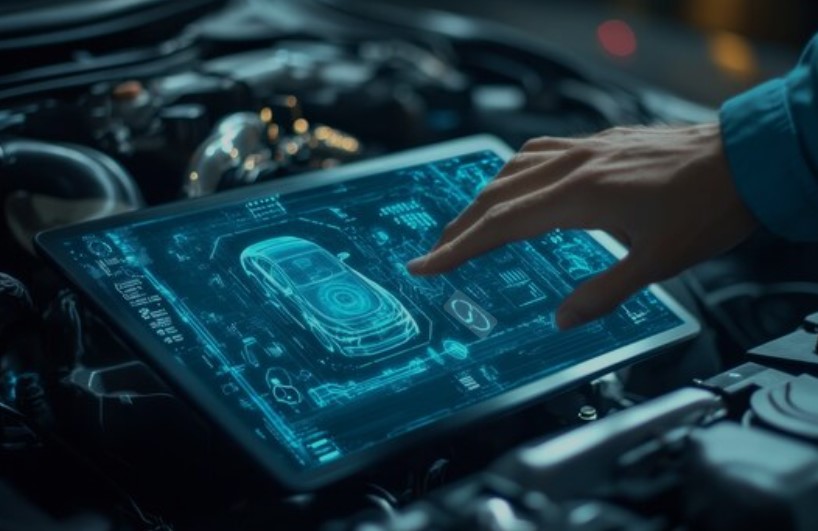The Role of Artificial Intelligence (AI) in the Automotive Industry
Introduction
Artificial Intelligence (AI) is revolutionizing the automotive industry, transforming how vehicles are designed, manufactured, and operated. From self-driving technology to predictive maintenance and enhanced safety features, AI is playing a crucial role in the future of mobility. With advancements in machine learning, computer vision, and natural language processing, AI-powered vehicles are becoming smarter, safer, and more efficient. This article explores the various applications of AI in the automotive sector, its benefits, challenges, and the road ahead.
1. Autonomous Vehicles (Self-Driving Cars)
One of the most significant breakthroughs in AI-driven automotive technology is autonomous vehicles. Companies like Tesla, Waymo, and General Motors are investing heavily in developing self-driving cars that rely on AI-powered systems to navigate roads safely. Key AI technologies in autonomous vehicles include:
• Computer Vision: AI-powered cameras and sensors detect and interpret road signs, lane markings, pedestrians, and obstacles.
• Machine Learning Algorithms: Vehicles learn from vast amounts of driving data to improve navigation and decision-making.
• LIDAR and RADAR Systems: These technologies help in object detection, depth perception, and real-time mapping.
• Path Planning and Control: AI calculates the safest and most efficient routes while adapting to traffic conditions.
Autonomous vehicles are classified into five levels, from Level 1 (driver assistance) to Level 5 (fully autonomous). While full automation is still under development, AI continues to enhance driving capabilities through advanced driver-assistance systems (ADAS).
2. Advanced Driver-Assistance Systems (ADAS)
AI-driven ADAS is improving vehicle safety and reducing accidents by assisting drivers with real-time alerts and automated interventions. Some of the key AI-powered ADAS features include:
• Adaptive Cruise Control (ACC): Adjusts vehicle speed based on traffic conditions.
• Lane Departure Warning and Lane-Keeping Assist: Prevents unintended lane changes.
• Automatic Emergency Braking (AEB): Detects potential collisions and applies brakes when necessary.
• Blind Spot Detection: Alerts drivers of vehicles in their blind spots.
• Traffic Sign Recognition: AI identifies and interprets road signs to assist drivers.
ADAS technologies are paving the way for increased automation, reducing human errors and improving road safety.
3. AI in Manufacturing and Quality Control
AI is transforming automotive manufacturing by optimizing production processes, enhancing quality control, and reducing operational costs. Applications of AI in manufacturing include:
• Predictive Maintenance: AI monitors equipment health and predicts failures before they occur, minimizing downtime.
• Robotics and Automation: AI-powered robots perform precise assembly tasks, improving efficiency and reducing errors.
• Defect Detection: AI-driven computer vision systems inspect components for defects, ensuring higher quality standards.
• Supply Chain Optimization: AI analyzes demand patterns and streamlines inventory management.
AI-powered smart factories are increasing productivity while reducing waste and production costs.
4. AI in Connected and Smart Vehicles
AI is enabling the development of connected vehicles that communicate with each other and infrastructure for a more efficient and safe driving experience. Key applications include:
• Vehicle-to-Vehicle (V2V) Communication: AI allows vehicles to share data on speed, position, and road conditions.
• Vehicle-to-Infrastructure (V2I) Communication: AI enables cars to interact with traffic signals, road sensors, and smart city infrastructure.
• Smart Infotainment Systems: AI-powered voice assistants, navigation systems, and entertainment features enhance user experience.
• Real-Time Traffic Optimization: AI analyzes traffic data to suggest alternative routes and reduce congestion.
Connected vehicles are shaping the future of intelligent transportation systems (ITS), making travel safer and more efficient.
5. AI for Predictive Maintenance and Diagnostics
Traditional vehicle maintenance is reactive, often addressing issues only after they occur. AI is shifting this paradigm by enabling predictive maintenance, which includes:
• Real-Time Vehicle Health Monitoring: AI analyzes sensor data to detect potential failures.
• Fault Prediction and Prevention: Machine learning models identify patterns that indicate wear and tear.
• Automated Service Recommendations: AI suggests maintenance schedules based on usage patterns and driving behavior.
Predictive maintenance reduces vehicle downtime, lowers repair costs, and extends the lifespan of automotive components.
6. AI-Powered Personalization and User Experience
AI is enhancing driver and passenger experiences by offering personalized services, including:
• Intelligent Voice Assistants: AI-powered assistants like Siri, Google Assistant, and Alexa enable hands-free control of vehicle functions.
• Driver Behavior Analysis: AI monitors driving habits to provide personalized recommendations for safer driving.
• Adaptive Climate Control: AI adjusts temperature and ventilation based on passenger preferences.
• Customized In-Car Entertainment: AI curates music, news, and content recommendations based on user preferences.
Personalized AI-driven experiences are making modern vehicles more intuitive and user-friendly.
7. AI in Traffic Management and Smart Cities
AI is playing a crucial role in optimizing urban mobility and reducing traffic congestion. Applications include:
• AI-Driven Traffic Signal Optimization: AI adjusts traffic light timing to improve flow and reduce delays.
• Intelligent Toll Collection Systems: AI automates toll collection, reducing congestion at toll booths.
• Smart Parking Solutions: AI-powered parking systems guide drivers to available parking spaces.
• Autonomous Public Transport: AI is enabling self-driving buses and shuttles for efficient urban mobility.
By integrating AI with smart city infrastructure, urban transportation is becoming more efficient and sustainable.
8. AI in Cybersecurity for Connected Vehicles
As vehicles become more connected, cybersecurity threats are a growing concern. AI is helping protect automotive systems through:
• Intrusion Detection Systems (IDS): AI monitors network activity to detect unauthorized access.
• Anomaly Detection: AI identifies unusual patterns that indicate potential cyber threats.
• Secure Software Updates: AI ensures safe and secure over-the-air (OTA) updates.
• Encryption and Authentication: AI enhances data security for vehicle communication systems.
Robust AI-driven cybersecurity measures are essential to prevent hacking and data breaches in connected vehicles.
9. Challenges and Ethical Considerations of AI in the Automotive Industry
Despite its many benefits, AI in the automotive sector faces several challenges, including:
• Safety and Reliability: Ensuring AI-powered systems function correctly in all driving conditions.
• Regulatory Compliance: Governments must establish regulations for AI-driven vehicles.
• Data Privacy: Protecting user data from misuse and cyber threats.
• Job Displacement: Automation in manufacturing may lead to workforce disruptions.
• Ethical Dilemmas: AI decision-making in life-threatening situations remains a controversial issue.
Addressing these challenges is critical for the successful adoption of AI in the automotive industry.
10. The Future of AI in Automotive Technology
The future of AI in the automotive industry is promising, with continuous advancements in:
• Fully Autonomous Vehicles: Achieving Level 5 automation for driverless mobility.
• AI-Driven Sustainability: Using AI to optimize energy consumption and reduce emissions.
• Human-AI Collaboration: Enhancing human-machine interaction for safer driving experiences.
• Integration with 5G and Edge Computing: Improving real-time AI processing for smarter vehicles.
• Expansion of AI in Public Transportation: Autonomous taxis, buses, and shared mobility solutions.
As AI technology evolves, the automotive industry will continue to benefit from smarter, safer, and more efficient mobility solutions.
Conclusion
Artificial Intelligence is revolutionizing the automotive industry, transforming everything from manufacturing and safety to user experience and connectivity. As AI-powered vehicles become more advanced, they promise to improve road safety, enhance efficiency, and create a more sustainable transportation ecosystem. However, challenges such as safety, regulation, and cybersecurity must be addressed to ensure a seamless transition into an AI-driven automotive future. With continued innovation and investment, AI will play a pivotal role in shaping the next generation of smart and autonomous vehicles.



